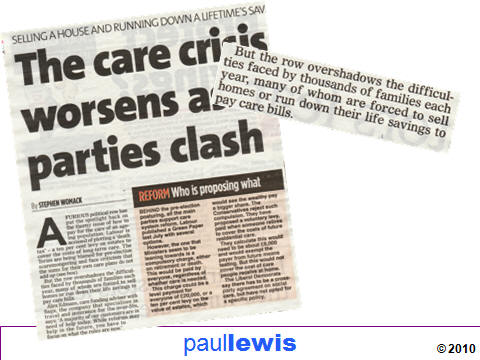
This talk was given 23 February 2010
The text here may not be identical to the spoken text
ASSOCIATION OF CHARITY OFFICERS
I’m
Paul Lewis a freelance financial journalist, although best known I guess for my
work presenting Money Box on Radio 4. But I also write the money pages in Saga
Magazine and write for its website.
I
am very glad to be here and again am was astonished at the range of benevolent
organisations that belong to the Association. I was pleased to see one of your
members is the Bankers’ Benevolent Fund – or Her Majesty’s Treasury as it’s now
known. The only charity where you round your application up to the nearest
billion. I also like the charity for Cooperative officials – I don’t meet many
of those in my profession. And the Commercial Travellers Benevolent Institution
– that must be an easy job – just wait for them to come knocking at the door.
Let
me start with politics. All parties agree that we need to reform the way that
care is provided for people as they age but don’t die. We all agree that ageing
without dying is a good thing. We all agree that care should be provided for
people in that phase of life. And when it comes to who will pay – then again we
all agree – someone should. But ‘who’ is where the consensus breaks down.
Here is the Daily Mail’s take on it
this week. Note the phrase ‘forced to sell their home’.

The
Conservatives say that if we all pay £8000 at 65 then the cost of care, should
we need it, will be free for life. But that is a little disingenuous Because
most of us never need residential care and of those who do most get it free
anyway. If you have continuing medical needs then the NHS pays without a
means-test. And if the NHS does not pay then if your assets are below £14,000
(England; Wales £19,000, Scotland £13,000, NI £13,500) then the local council
pays. So the invitation is to pay £8000 at 65 to get something free which you
may well not need and would probably be free anyway.
For
most people affected by that rule it is the value of their house or flat which
might take them above that level – average house price is around £165,000. And
it is that fear which leads to headlines such as this in the
Daily Express a month ago.
Spitfire ace forced to sell his house to pay for care home fees

The Daily Mail joined in and both had
trenchant editorials and copy such as “Labour’s betrayal of the elderly was laid
bare yesterday as a hero Spitfire pilot faced having to sell his home to pay for
residential care”
Now
the rules are complicated and I suppose I shouldn’t blame fellow journalists for
getting them wrong.
But
in case this topic ever comes your way – as I am sure it will in grant giving
charities – here is what you have to remember.
No-one, ever, can be forced to sell their home to pay for their care.
Why?
1. If you leave behind a spouse or partner living there then the value of the
home is completely ignored.
This Express story fell at this first
hurdle as 88 year old Mr Mejor did leave behind a wife Cecile. That was
dismissed by the Express in para 13
as ‘a glimmer of hope’. Never let the facts get in the way of a good story!
2. If a relative aged 60 or more lives
there then the value of the home is completely ignored. Mr Mejor’s daughter
Sally aged 54 lives in the house as a carer for her mother. So if the
94-year-old Cecile survives another six years, the house will not count even
when she dies.
3. If someone who acts as a carer lives there then the local authority has the
discretion to ignore the value of the home.
So
the Express story could fail there
too – even if Cecile dies before Sally is 60.
But
suppose that doesn’t happen – no spouse, no relative over 60, no carer, an empty
house or flat?
It
still doesn’t have to be sold.
For the first twelve weeks in the home the value of the home is ignored. And
after that there can be a
deferred payment agreement. Introduced in October 2001 this agreement allows the
resident not to pay for their care at the time. Instead the bill clocks up every
week but nothing is paid. Instead the local authority takes a legal charge on
the home so that when the person dies or the home is sold the care bill is paid.
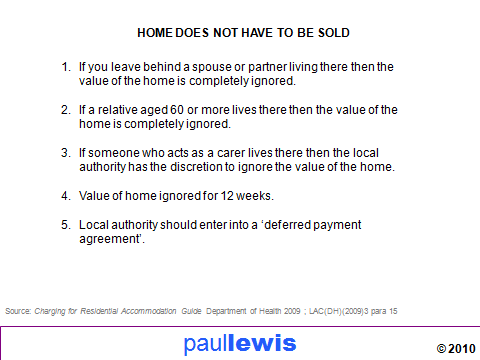
The care bill is added up each week without interest being charged. So it is an
interest free loan. No interest is charge until 56 days – 8 weeks – after the
person in the home dies.
And
of course while that is happening the property can be rented out or lived in by
a younger friend or relative to keep it in good order.
The income from that can be used to pay the care home fees.
In
this way the amount lost on death from the value of the home can be minimal.
Now
not all local authorities offer deferred payment agreements – though they
should. They were reminded in England in April 2009 that if a council did not
then “it is likely the courts would find this to be unlawful”. Similar rules
apply in Scotland and Wales.
[LAC(DH)(2009)3
para 15]
But
what if Cecile dies, daughter Sally is still under 60, discretion isn’t
authorised, and the council does not offer a deferred payment agreement will Mr
Mejor have to sell his home?
No.
Under the National Assistance Act 1948 the local authority has to provide
accommodation for elderly people who need care. And that obligation is not
extinguished if the person receiving the care refuses to pay for it.
The
procedure in those cases is set out in s.22 of the Health and Social Services
and Social Security Adjudications Act 1983 – usually known as HASSASSA. It says
the local authority has to place a charge on the Land Registry against the value
of the property but cannot charge interest on the debt while the person is
alive. And the only real difference is that interest is charged from the day
after the person’s death rather than waiting for 56 days.
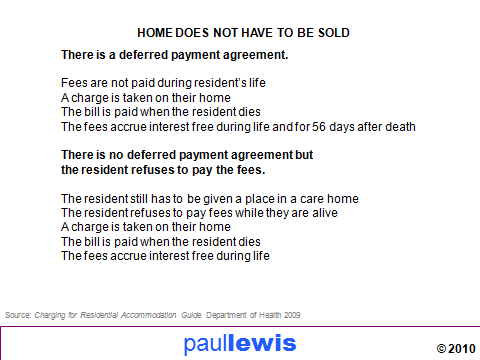
So
even without a deferred payment agreement the debt can build up interest free
until the resident in the care home dies.
You
just have to be firm. But if you are, no-one has to sell their home to pay for
their care.
I
find all this particularly frustrating because I wrote about it in an article in
Saga Magazine in November 1994 where
I set these rules out. I called it ‘Hold on to your home’.
Here it
is. And here is what I wrote then. – “They cannot force you to sell your home.”
And the rules have not changed since then – unlike the photograph.

So. No-one ever can be forced to sell their home to pay for their care.
But here is The Daily Telegraph a
couple of months ago.
And the Mirror of the same day

So
where does this figure come from? And what does it really mean?
It comes from two sources. First is an annual survey done by the health analysts
Laing & Buisson. Each April year it does a survey of all the people in care
homes in the UK. And it found in April 2009 there were 380,000 elderly people in
care homes.
Of them 199,000 were paid for by the local council,
another
26,000 were fully funded by the NHS. L&B assumes that the balance of 155,000 is
the number who pay for themselves – self-funders. We don’t know they’re
self-funders they are just a residual number.
But
how many of those sold their home to pay for their care?
Now we need other research and the only one was by the DWP in 2001. It found
that of those who paid for themselves 81% owned or had their own home
Of those 51% just over half had sold their home prior to entering care
And of those who had sold their home three quarters had done so to fund their
care.
So you finally come to about 48,000 people in a care home in 2009 who had sold
their home to pay for it.
Now, as the House of Commons researcher who did this calculation says in her
note
“these estimates are very crude approximations and should be considered with
caution”.
There are two things to note about them.
1.
There is no evidence whatsoever about how many of these 48,000 people were
‘forced’ to sell their home. They may have done so to get better care – a room
of their own, a room with a view, a room in a home that the local council
considered too luxurious.
2.
This is the number of people in care in 2009 who had sold their home
at some time in the past to pay for
it. But it is widely misquoted wrongly as being the number of people who have to
do that each year.
The average time in a care home is two and half years so if 48,000 in care homes
had sold their home one can sort of say that the number selling their home each
year is 48,000/2.5 = 19,200. About one in twenty of those in a home
But
remember these figures depend on a sample survey done in 2001. At their best
they are flaky.
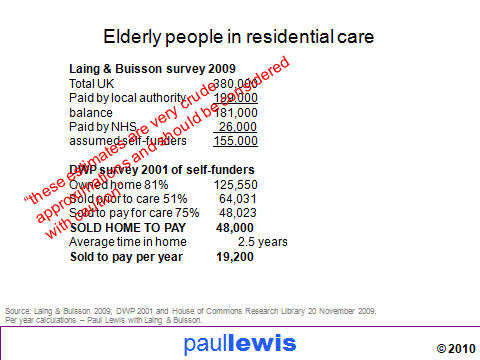
But
big figures are very attractive to politicians trying to say as they do that
Labour has betrayed thousands of pensioners. Liberal Democrats and Conservatives
have used the figures to say 45,000 (which was the 2008 number) people
every year have to sell their home
to pay for their care. That is simply false.
So
about 19,000 people a year probably sell their home to pay for their care but
they did not have to. And remember that most people never go into a home –
perhaps one in five of us does, it may be less. And of those who do about one in
twenty sells their home to pay for it. One in a hundred of the population.
People like my neighbour Margaret. She was in her eighties and had two hip
operations neither of which worked well. Using a zimmer frame, struggling up and
down stairs and then dementia began. She sold her house to pay for her own care
near friends, by the seaside and got a much higher standard of care for the
eight months she lived than if she had struggled to get the council to provide
her with something suitable in London. She is one of those 19,000 who sold their
home to pay for their care in 2009. I am very glad she did. And I am sure she
was too.
But
the parties are now discussing who should pay for the care for those living
longer lives.
Conservative plans involve a voluntary payment of £8000 at the age of 65. It’s
an insurance scheme. And it would only pay for the same care you get now. And
it’s not to provide free care – because if you have no available assets you get
that anyway. But to protect your estate. So the financial beneficiaries are the
heirs not the person in care.
And
then of course there is the Labour scheme.
Care
will be paid for by a death tax of £20,000 according to the famous Conservative
poster. Well it might be. The consultation Green Paper published last July says
that someone of 65 will probably need £30,000 worth of care before they die.
That includes care at home as well as care in a home. Whereas the Conservative
plans are just for care in a home not prior care at home, hence they are cheaper
than Labour’s and voluntary.
And
the £20,000 death tax was sort of mentioned in that Green Paper.
Option 3, the insurance option, says
“after
their death…
£20,000”
Option 4 says
“£20,000…after
their death.”
So
that is where the £20,000death tax comes from. And a death tax of £20,000 from
everyone who owned a home on their death would raise about £8 billion a year.
Which is comparable to total council spending in England on personal social care
for people aged 65 and over which the Audit Commission tells us was £9.1 billion
in September 2009. (National
Adult Social Care Information Service, Personal Social Services Expenditure
and Unit Costs, England Provisional 2008/09, NHS Information Centre,
September 2009. Cited in Under Pressure
Audit Commission February 2010).
But
now I am told that when the Government announces its plans – probably in March
which is enough time before the election to influence it but not enough time of
course to actually change anything – I am now told by the Dept of Health – in
the name of Andy Burnham Sec of State for Health
“No
decision has been made yet on how this necessary reform will be funded, but a
£20,000 flat fee after death is not an option we are considering.”
So
the poster worked.
Because for reasons I have never understood Inheritance Tax is just about the
most hated tax – second only to council tax.
I write guides to Inheritance Tax – how it works, how to reduce it and so on. But I always start by saying something like this –
why is
it hated? it is due when you are dead. Someone else pays it. The ideal tax for
me.
That’s from my book Pay Less Tax 2010
due out later this year from the charity formerly known as Age Concern whose new
name Age UK is still a secret.
Now
if there was a new death tax to pay for care then (a) and (b) would certainly
still be true – when you are dead and paid by someone else. Though (c) would
probably not be as about 70% of the retired population own their home and just
about all of them have that much equity in it. Hence the income of £8 billion a
year from a flatrate death tax of £20,000.
But
(c) currently is true – and even more so since the Chancellor made the
Inheritance Tax allowance portable from one married or civil partner to another
in October 2007. Couples with assets of less than £650,000 need not worry about
Inheritance Tax.
Here are the figures. In 2008 nearly 580,000 people died in the UK. And in
2008/09 16,000 estates paid Inheritance Tax. That is less than 3 estates in 100.
In fact it is one in every 36. In other words out of 36 funerals you see only
one of those families in black will have to worry about Inheritance Tax. It is a
minority concern.
But
even those who do pay it shouldn’t care. Not just because they are dead. But
their heirs shouldn’t care. Almost all those people who do fear they will have
to pay the tax should realise it is due not on money they have earned or saved.
It is due on a windfall gain on the home they live in.
If you are 80 now and paid off your mortgage at 65 and bought that house at 50.
Suppose that home is now well into the IHT band. Suppose it is worth £500,000 –
now for most people who are or have been a couple no tax will be due on that.
But if you are single or haven’t arranged your affairs sensibly then tax may be
due. So let’s ignore that fact.
If it is worth £500,000 now and you bought it 30 years ago it was then £67,750.
Now you may have struggled to pay that mortgage off over the next 15 years –
average pay then was around £4,100 a year. So it was about 16.5 times average
earnings. But you managed it. Today that house is worth about 20 times average
earnings - £500,000. So you have a windfall gain of £432,250. Money you haven’t
earned in any sense of the word. And even if you take account of the cost of
borrowing most of that money the windfall is still nearly £400,000.
That has been created by inflation, by wage rises, by the economy of the
country, by the state you live in. So why shouldn’t the state take some of it
back? £20,000 a twentieth of the total. In many countries that capital gain on
your home would be taxed while you were alive. Here it is not even taxed on
death.
And
while we are talking of inheritance tax can I tell of another thing that really
annoys me. And this time it is what charities do.
Here is the Inheritance Tax page from the Woodland Trust website – I pick that
because it’s the first I found – but there are dozens of them.

Let’s look at Example 1 in more detail.
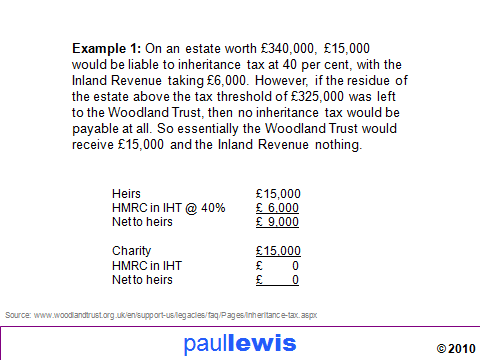
That is true – but misleading. Suppose you left nothing to charity?
£15,000
would be liable to IHT and taxed at 40%. So of that £15,000, the Revenue would
get £6000 and your heirs £9000.
If you
leave £15,000 to the Woodland Trust then the Revenue gets nothing out of that
£15,000 but nor do your heirs! They get £9000 less of your estate. So in fact
the heirs make a bigger donation to the Woodland Trust than the person who has
died.
Now
it is good to leave money to charity. And I know a lot of you depend on it. But
it is not a tax planning technique. It is better for your heirs to have 60% of
something than 100% of nothing.
So
please in your desire to raise money in wills don’t mislead people like this. It
is one of those financial pitches that is true but misleading – indeed it is
worthy of the financial services industry itself.
And
talking of which, I have been shocked this month to discover that the annual
cost of policing the UK financial services industry and compensating customers
when things go wrong will top £1 billion for the first time in 2010/11. That is
more than £20 for every adult in the country. And we all pay it through the
price of insurance, loans, mortgages, investments, and banking services –
including the low rates on savings accounts.
Almost half the money – £455 million – is needed to pay for the expanding
Financial Services Authority. It is taking on 460 extra staff – in addition to
the 280 extra recruited this year. The FSA has already announced it will have to
pay its staff more money to recruit and keep the quality people it needs.
Since
it began to be fully operational in 2000 the cost of the FSA
has
rocketed from under £200 million to a forecast of almost £500 million in the
coming year. One reason is that it now regulates more sectors – insurance and
mortgages have been added – and it is now expanding further to make sure its
supervision of banks is rather better than it was before the 2008 crisis.
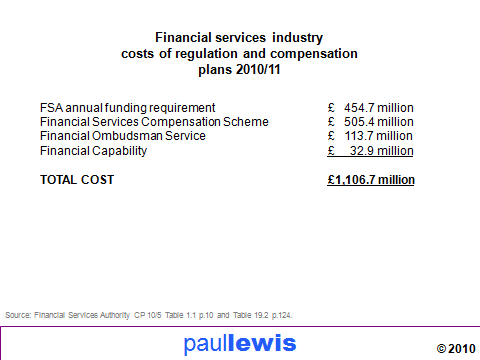
Slightly more – £505 million – will pay for the Financial Services Compensation
Scheme. It coughs up when people lose money due to regulated firms going bust.
About three quarters of this money is interest on the £20 billion which the
Treasury lent the scheme to ensure savers got all their money back when five
banks and one building society went bust in the crash of 2008. No-one knows when
or if the capital will ever be repaid but the interest has to be repaid
annually. That cost is about £375mn and the rest, say £130 million, is the
estimated cost of direct compensation for other failed firms.
Add on nearly £114 million to run the Financial Ombudsman Service and almost £33
million for financial capability – which will soon be the responsibility of a
new consumer financial education body – and the grand total comes to £1.1
billion. All of which will be added on to the price of the financial products we
buy in 2010/11.
But
hang on! Did I just say £33 million for financial capability? Out of more than
£1 billion to police the financial services industry and compensate customers
for its mistakes? In other words what is being spent on helping us to understand
the complex products which the industry sells is just 3% of the total cost of
putting things right?
I
did. And in my view far too much. When I spoke to some of you last year I
expressed this view:- I am against all this effort being put into financial
capability.
How
can I be against helping people understand their finances as a way of managing
them better. Surely everyone is in favour of that?
Of
course I am not against people understanding their finances and being sceptical
about the offers they are made by banks and financial companies – as they should
be sceptical about any retail offers. I spend almost all of my working life
trying to help people understand money and the way financial companies operate.
But thinking that financial capability is the answer to the financial
difficulties of low income households is simply a mistake.
Now I am going to take some facts and a clip from a programme made by my
colleagues on Woman’s Hour and broadcast just over a week ago. The programme
began with this question
What is 1.12 x 2.2
It
was we were told a question an 11 year old should be able to answer. But a fifth
of adults have numeracy skills below those of that 11 year old. And adult women
are more likely to have poor numeracy than adult men – a third of women say they
struggle with maths. And a third of parents say they avoid helping their
children with their maths homework because they feel incapable.
The
programme then played this selection of women asked are you good at maths?
And
indeed what is 1.12 x 2.2?
2.46
The
reason the banks make money – and yes even now the retail bits of the banks are
highly profitable – Barclays for example, between retail banking and Barclaycard
it made £1.4bn in 2009 on a turnover of £8bn. Those figures were a lot down on
2008 but still not at all bad in a tough year.
And
the reason they make that money is because they are better at arithmetic than
the rest of use. And no amount of financial capability training is going to
change that. It is like trying to give everyone tennis capability so they can
stop losing money when they play Andy Murray. It is not going to work.
And
the only reason people need financial capability is because the products they
are sold are complex, the descriptions of them are misleading, though true, and
some of them are dangerous.
It is part of a process which I call complexification. Making financial services
so complex that the human brain cannot make rational choices, ends up making bad
ones, but usually doesn’t even understand what it has done wrong. And if it does
work it out and complain it is referred to paragraph 94(a)(i) blobby point five
which, somehow, they failed to read and understand before they bought the
product.
So
financial capability is a problem for the financial services industry not for
the consumer. If we accept, even for a moment, that it is the confused who are
to blame rather than those who are confusing them, we turn mis-selling which is
rife and an embarrassment for the industry, into mis-buying which lets them off
the hook if they put a few pounds – OK £33 million – into a financial capability
programme.
Rather what we need is tough regulation, not of process but of products. Not of
how things are sold but of what is sold.
I bought a car the other day. And I was faced with a choice. Toyota or a car
with brakes that work? No. Actually I did buy a Prius – some controversy over
how it is pronounced. Prious Preeus. I go with Prious – rhymes with Pious –
because they do come with smugness built in? The car in front is a Toyota – why?
Because its accelerator is stuck on and its brakes don’t work. What colour would
I like – maybe metallic paint? Did I want a sporty number with two seats? Or a
family vehicle that could fit a table and a dog in the back? How about built in
sat nav? These are all valid consumer choices.
But
if this had been sold by a financial adviser I would have been asked what
tensile strength glass did I want in the windscreen? It all depended on my risk
reward ratio. Plain window glass was clear, you could see through it probably
better than normal windscreen glass. And it would cost me a lot less. But there
was an outside chance that a stone might hit it and then it would break and
shower me with razor sharp glass shards? What was my risk profile?
Luckily it was a car. I didn’t have to search the internet for information about
the brake linings you needed for a 1.8 litre engine. I didn’t have to decide
where I wanted air bags. All those things are laid down. In the law. The car I
bought will be safe. It is illegal to sell one that isn’t. So I didn’t have to
have to take a vehicle literacy course so that I could make rational choice
about the car I bought. I was allowed to make the choices that a customer
can make – colour, fuel consumption,
upholstery. And of course if there is a fault found – it is recalled and mended
free – as 8 million Toyotas are being this month.
But
imagine if the sale of cars was regulated by the Forecourt Sales Association –
FSA for short. it would be perfectly happy if I
was sold a car with a windscreen
made of window glass. As long as the risk was explained to me in paragraph 94
(b) (ii) blobby point five. ‘In some circumstances window glass can shatter.’
You were warned.
That’s because the FSA regulates not products but process. As long as an item is
sold correctly and the risks explained then it does not have to fulfil any other
standards.
Now
I made up the Forecourt Sales Association. But there is another FSA and it does
regulate products. And it does tell us who is doing what.
17
August 2009 Shutki Raja Chutney Powder. The FSA has issued a Food Alert. Local
authority food law enforcement officers must make sure the chutney is withdrawn
from sale and destroyed.
No
problem was found with Shutki Raja Chutney Powder. Except that it had been
produced on unregistered, or possibly unapproved, premises. So the product was
named and withdrawn and destroyed.
17
March 2009 Active brand peanut butter has been found to be contaminated with
excess levels of aflatoxins. The Agency has issued a Food Alert. If any of these
products are found, enforcement officers should ensure they are withdrawn from
sale and detained.
It’s a great job isn’t it? What did you do at work today? I detained a jar of
peanut butter.
Compare that with its namesake that regulates financial products. Aflatoxin in
peanut butter. It would immediately swing into action and order a thematic
study. And a spot of mystery shopping. After some months it would publish the
results calling on the industry to take action to explain clearly to customers
what aflatoxins were. After giving the industry several months it would order a
second round of thematic work and a bit more mystery shopping. The next year it
would publish a review and ask for comment. A few months later a Consultation
Paper would appear on how these ingredients should be described and discuss
whether they were ever completely inappropriate. A few months after that it
would publish the results of the consultation paper setting out what it planned
to do. Food manufacturers could object. It would then issue a feedback statement
with a draft a timetable to make changes in the rules. And six months later
decide that more time was needed as otherwise there was a real danger than
peanut butter would not be available for everyone’s sandwiches and that changes
would not be ordered until 2012.
Meanwhile the businesses that had been found to be selling food contaminated
with aflatoxins would not be named. Their identity would be kept secret from
consumers. So the FSA would know who was selling dangerous food and under what
brand names. But it wouldn’t tell customers.
Much better to be like the Food Standards Agency – ban them. Issue a notice and
destroy them. ‘My goodness’ I am told ‘we can’t work like in the finance
business! If we went round banning things it might destroy confidence in the
industry. Then no-one would buy pensions or investments. And that would be a bad
thing – wouldn’t it?’
Among that list of products reported by the Food Standards Agency recently there
was this
20
November 2009 Tesco has withdrawn two batches of its own-brand wholegrain brown
rice because they might be contaminated with insects. The Agency has issued a
Food Alert for Information.
12
November 2009 Coca Cola Hellenic Bottling Company has withdraw certain batches
of Dr Pepper in Nothern Ireland, because of high levels of benzoic acid.
Big
brands. Named. Does it stop people shopping at Tesco? No. Does it make give up
their Dr Pepper addiction? No.
Rather we buy food with confidence because we know that the Food Standards
Agency is there, naming products, withdrawing products, detaining jars of peanut
butter and ultimately banning and destroying products.
That is my vision for the future of financial regulation.
